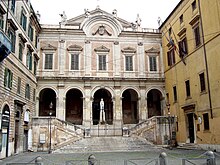
The Basilica of Saint Clement is a Latin Catholic minor basilica dedicated to Pope Clement I located in Rome, Italy. Archaeologically speaking, the structure is a three-tiered complex of buildings: (1) the present basilica built just before the year 1100 during the height of the Middle Ages; (2) beneath the present basilica is a 4th-century basilica that had been converted out of the home of a Roman nobleman, part of which had in the 1st century briefly served as an early church, and the basement of which had in the 2nd century briefly served as a mithraeum; (3) the home of the Roman nobleman had been built on the foundations of republican era villa and warehouse that had been destroyed in the Great Fire of AD 64.

The Basilica of Santa Maria in Trastevere ; English: Our Lady in Trastevere) is a titular minor basilica in the Trastevere district of Rome, and one of the oldest churches of Rome. The basic floor plan and wall structure of the church date back to the 340s, and much of the structure to 1140–43. The first sanctuary was built in 221 and 227 by Pope Callixtus I and later completed by Pope Julius I. The church has large areas of important mosaics from the late 13th century by Pietro Cavallini.

There are more than 900 churches in Rome, which makes it the city with the largest number of churches in the world. Almost all of these are Catholic.

The Church of Saint Susanna at the Baths of Diocletian is a Roman Catholic parish church located on the Quirinal Hill in Rome, Italy. There has been a titular church associated to its site as far back as AD 280. The current church was rebuilt from 1585 to 1603 for a monastery of Cistercian nuns founded on the site in 1587, which still exists there.

Sant'Anastasia is a minor basilica and titular church for cardinal-priests in Rome, Italy owned by the Syro-Malabar Catholic Church.

San Marcello al Corso, a church in Rome, Italy, is a cardinalitial titular church whose cardinal-protector is normally of the order of cardinal priests.

San Marco is a minor basilica in Rome dedicated to Saint Mark the Evangelist located in the small Piazza di San Marco adjoining Piazza Venezia. It was first built in 336 by Pope Mark, whose remains are in an urn located below the main altar. The basilica is the national church of Venice in Rome.

Santa Balbina is a Roman Catholic basilica church in a quiet area on the side of the Aventine Hill, in Rome. It is next to the Baths of Caracalla.

The Minor Basilica of St. Lawrence in Damaso or simply San Lorenzo in Damaso is a parish and titular church in central Rome, Italy that is dedicated to St. Lawrence, deacon and martyr. It is incorporated into the Palazzo della Cancelleria, which enjoys the extraterritoriality of the Holy See.
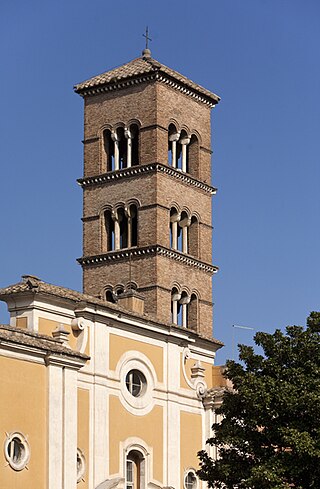
The Basilica of San Sisto Vecchio is one of the over sixty minor basilicas among the churches of Rome, and a titular church since 600 AD. As such, it is connected to the title of a Cardinal priest, currently Antoine Kambanda.

The Basilica of St. Bartholomew on the Island is a titular minor basilica, located in Rome, Italy. It was founded in 998 by Otto III, Holy Roman Emperor and contains the putative relics of St. Bartholomew the Apostle. It is located on Tiber Island, on the site of the former temple of Aesculapius, which had cleansed the island of its former ill-repute among the Romans and established its reputation as a hospital, continued under Christian auspices today.

Santa Francesca Romana, previously known as Santa Maria Nova, is a Roman Catholic church situated next to the Roman Forum in the rione Campitelli in Rome, Italy.

Santa Maria in Via is a church in Rome. The church or a chapel existed in the 9th century, but was rebuilt following reports of a miracle. In 1165, it is recorded as Santa Maria in Via, whose appellative means "on the Way", with a reference to the nearby Via Flaminia.

The basilica of San Pancrazio is a Roman Catholic ancient basilica and titular church founded by Pope Symmachus in the 6th century in Rome, Italy. It stands in via S. Pancrazio, westward beyond the Porta San Pancrazio that opens in a stretch of the Aurelian Wall on the Janiculum. It covers the Catacomb of San Pancrazio.

San Giovanni a Porta Latina is a Basilica church in Rome, Italy, near the Porta Latina of the Aurelian Wall.

The Basilica dei Santi Bonifacio e(d) Alessio is a basilica, rectory church served by the Somaschans, and titular church for a cardinal-priest on the Aventine Hill in the third prefecture of central Rome, Italy.
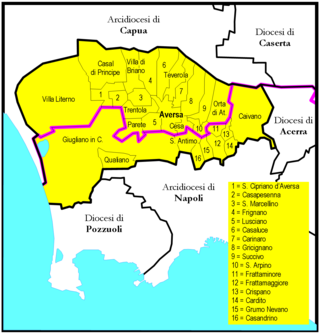
The Diocese of Aversa is a Latin diocese of the Catholic Church in Campania, southern Italy, created in 1053. It is situated in the Terra di Lavoro (Liburia), seven miles north of Naples, and eight miles south of Capua. It is suffragan of the Archdiocese of Naples.
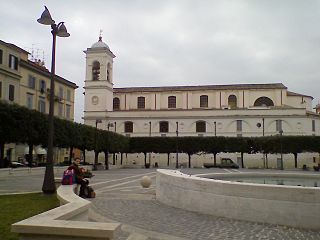
The Diocese of Albano is a Latin suburbicarian see of the Diocese of Rome in Italy, comprising seven towns in the Province of Rome. Albano Laziale is situated on the Appian Way some 15 kilometers from Rome.
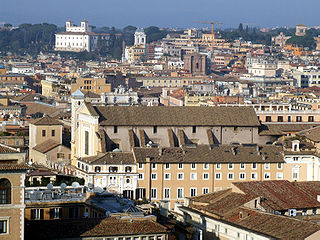
Santi Dodici Apostoli, commonly known simply as Santi Apostoli, is a 6th-century Roman Catholic parish and titular church and minor basilica in Rome, Italy, dedicated originally to St. James and St. Philip, whose remains are kept here, and later to all Apostles. Today, the basilica is under the care of the Conventual Franciscans, whose headquarters in Rome is in the adjacent building. It is the Station church for Friday, the first week of Lent.

Fulvio Giulio della Corgna was a Tuscan Catholic bishop and cardinal.
